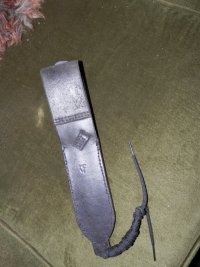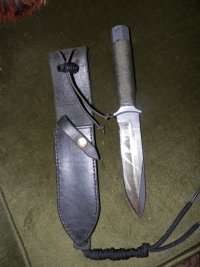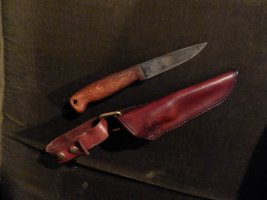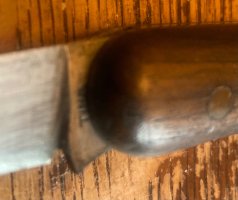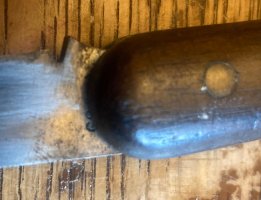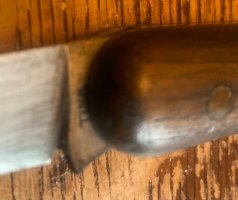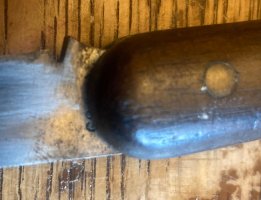A couple of items I thought I might add before the thread dies away.
This is strictly a letter opening knife with no other realistic purpose. The blade is of stainless steel while the handle is a piece of artillery shell shrapnel. It's something from my Trench Art collection.

Close examination shows a recess in the metal where a copper band once fitted around the shell. These copper bands expanded when the propellant charge ignited and the expansion caused them to grip the rifling of the gun barrel and impart the necessary stabilising spin to the shell. They were known as 'Driving bands' and were of course lethal when they fractured as the shell burst.

The bullet forming the cross guard is common Lebel bullet bearing a French Armoury stamp ATS. The thick black paint applied to the handle serves a good purpose apart from rust protection as the raw jagged shrapnel is as sharp as it was a hundred years or so ago.

I posted elsewhere some time ago about this folding knife, but it may interest BCUK.
In 1860 an American Electrician travelled to England with the idea of selling Lightning Conductor Rods as part of his business. The story is told that he observed hungry stray Dogs eating ship's Biscuits ( Hard Tack) which had been thrown into the river from ships and subsequently washed ashore onto the river banks. I've heard either the River Mersey or River Thames, depends who's spinning the yarn..

As an enterprising sort of gent, he had the idea of producing biscuits especially for Dogs. His name was James Spratt and by 1870 he had a large factory in the East End of London producing Dog Food. Bearing in mind that up to this date dogs had always been fed basically human food leftovers. Spratt expanded to selling food for Game Birds because he found the British Game shooting Estates eager customers for his specially formulated Game Bird feeds. Like all Salesmen he liked to encourage his customers with little gifts, particularly Game Keepers responsible for ordering his products.
This knife once belonged to a Scottish Keeper from a very large Shooting Estate in the Scottish Borders.


In an era of paper cartridge cases which not infrequently became difficult to extract, the knife has both 12 and 16 Bore extractor claws built into the Bolster.

A button Hook for shooting Gaiters and Corkscrew for his Lordship's lunch time Wine were also useful tools on the knife.

As a closing thought. A man named Charles Cruft became one of Spratt's top salesmen. He travelled abroad selling Dog Food and while in France was invited to organise a Dog Show by some of his customers, something he later expanded to Cruft's Dog Shows, now a rather well known event in the Doggie world calendar.




